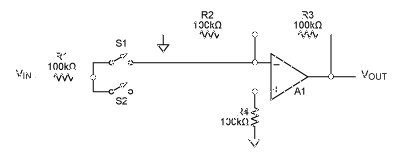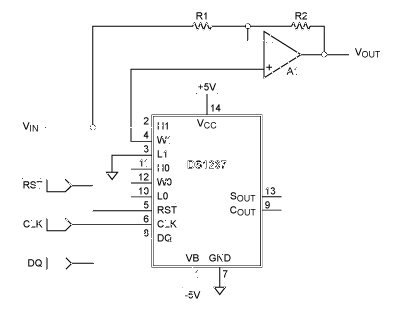 0
0








 0
0








This technical presentation requires an understanding of how to configure an operational amplifier in a typical gain control circuit. The applications of linear and nonlinear digital potentiometers are discussed. This article gives an overview of the basic techniques required to convert audio and other potentiometer/op amp applications from conventional mechanical potentiometers to solid state potentiometers. It also provides the background knowledge needed to implement digital potentiometers to replace mechanical potentiometers used in calibration and bias control for applications such as industrial control, audio, and telecommunications.
The circuit shown in Figure 1 provides a means of amplifying the signal in either inverted or in-phase mode. When switch S1 is off and S2 is on, the circuit behaves as a conventional inverting amplifier. When S1 is on and S2 is off, the signal is fed to the op-amp's in-phase input, so the circuit behaves as an in-phase amplifier. If S1 and S2 are monolithic analog switches, the circuit can be controlled by digital signals.
Introduce
Figure 1. When S1 is open and S2 is closed, the circuit is an inverting amplifier with gain -1. When S1 is closed and S2 is open, the circuit is an in-phase amplifier with a gain of +1

Digital potentiometer simplified circuit
Potentiometers can be used instead of switches. When the cursor is at the high end of the potentiometer, choose the same phase mode; When it is at the other end, select the inverting mode. Using linear digital potentiometers such as DS1267, as shown in Figure 2, it is possible to digitally control not only the polarity of the amplifier, but also the gain of the amplifier. Because many digital potentiometers use dual configurations, it allows for the use of "extra" potentiometers in the circuit to accomplish this signal processing task. The gambit value of the potentiometer is written through a 3-wire interface consisting of /RST, CLK, and DQ.
When the vernier value is 000000000, the vernier sets the vernier to the low end of the potentiometer, making it an inverting (gain = -1) circuit. A vernier value of 11111111 sets the vernier to the high end of the potentiometer, putting the circuit in an in-phase (gain = +1) configuration. The cursor setting between these values will cause the gain scan to change from +1 to -1.
Figure 2. Using a digital potentiometer instead of S1 and S2, the digital control of this circuit gain can be scanned from -1 to +1. A feature of the DS1267 is that when the cursor is centered on the potentiometer, it is powered on so that the levels of the inverting input and the in-phase input are equal. This results in no output for the operational amp, resulting in an effective power-on mute feature

Other functions
Another feature of this circuit is that when the DS1267 is first powered on, the vernier is automatically set to the midpoint of the potentiometer. This causes an equal signal to be sent to the op-amp input, resulting in no signal for the op-amp output - in effect, creating the power-on mute feature!
This circuit configuration can use the DS1802 logarithmic potentiometer, but because of the logarithmic taper, the smooth transition from inverse-phase gain to in-phase gain cannot be achieved. Some gain control is possible, but there is no symmetry between the two modes of operation. However, the switching action between -1 and +1 gain can be accomplished simply by jumping between the high and low end of the potentiometer, so an "extra" potentiometer can be used instead of an analog switch.